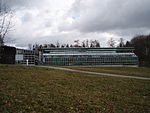Ulm-Söflingen station
Pages with no open date in Infobox stationRailway stations in Ulm

Ulm-Söflingen station is a railway station in the Söflingen district in the town of Ulm, located in Baden-Württemberg, Germany.
Excerpt from the Wikipedia article Ulm-Söflingen station (License: CC BY-SA 3.0, Authors, Images).Ulm-Söflingen station
Bahnhof Söflingen, Ulm Weststadt
Geographical coordinates (GPS) Address Nearby Places Show on map
Geographical coordinates (GPS)
| Latitude | Longitude |
|---|---|
| N 48.4029 ° | E 9.9588 ° |
Address
Bahnhof Söflingen
89075 Ulm, Weststadt
Baden-Württemberg, Germany
Open on Google Maps








